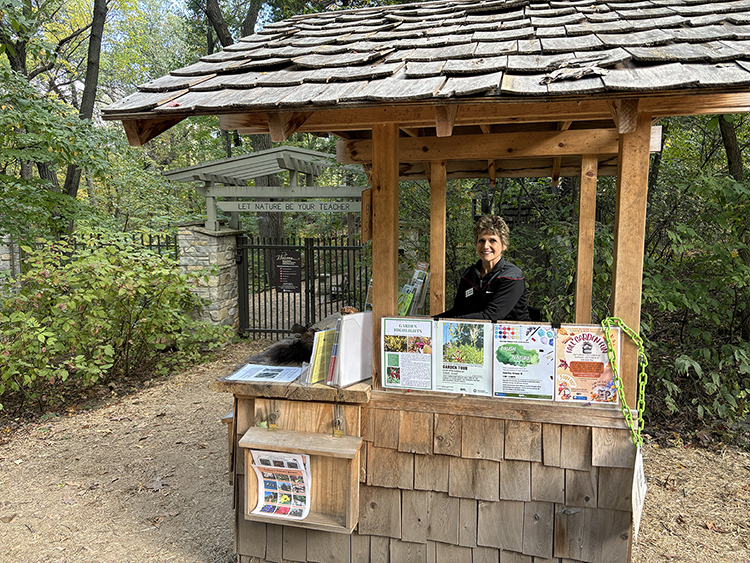President's Letters
As published in The Fringed Gentian™.
Fall 2024
Volume 72, No. 3
Dear Friends,
The mission of the Friends of the Wildflower Garden is to protect, preserve, and promote the interests of the Eloise Butler Wildflower Garden and Bird Sanctuary as a sanctuary for native flora and fauna of Minnesota, and to educate and inspire all people in relating to the natural world.
From our supporters who donate annually or as a one-time gift, these monies are invested until the Garden has projects which need funding. This fall the Friends will donate almost $100,000 for a new fence connecting the fence constructed several years ago to the Back Gate. This fence will create a new eastern boundary expanding the Garden to 18 acres.
This summer the Friends contributed $3,000 for transporting 400 Minneapolis schoolchildren to the Garden to learn about and enjoy the natural world. The $10,000 second bee census was completed in September by the U of M, funded jointly by the Friends and MPRB.
Below: Volunteer Brenda Kemmerick manning the entry kiosk in October. Photo Richard Sveum

Many others volunteer their time to the Garden by greeting visitors and answering their questions at the Front Gate Kiosk or in the Shelter. Melissa Hansen has worked hard to schedule 22 volunteer shifts per week. Besides these 41 volunteers, there are 14 Legacy Volunteers who manage invasive plants in the perimeter areas around the Garden which have been previously cleared of buckthorn and garlic mustard. This year there have been nine larger invasive pulls, and several pop-up events coordinated through social media involving Friends of the Invasive Plants Action Group (FIPAG) with 72 volunteers led by Jim Proctor.

Minnesota ranks third in the US for volunteering rates at 35.5%, just behind Utah (40.7%) and Wyoming (39.2%), as reported in the most recent 2021 US Census Bureau data. Independent Sector estimates the value of volunteer time in Minnesota at $36.31 per hour. If all the shifts were filled in the Shelter and Kiosk, that would be a contribution of $1,900 per week. In 2024, FIPAG contributed 540 hours to managing the area in Wirth Park around the Garden.
One Kiosk volunteer greeted two young women from Ethiopia, beautifully dressed in floral garb for their New Year, who “wanted to spend time with the flowers.” They were ecstatic that the meadow yellow composite flowers matched the colors of their outfits! Another encounter was a middle-aged woman who shared that when she was in college in Mankato, “this Garden was her sanctuary.” An hour later, a younger woman of color visited. When asked if she had been to the Garden, her answer was “I come every week, and this is my sanctuary.” Recently a grade school student came to the Garden with her binoculars and was thrilled to see warblers, which she correctly identified.
For many of the volunteers, their reward is the joy of the visitor interactions or the satisfaction of improving the understory of the surrounding woodlands.
On September 25, Heather Holm, biologist and pollinator conservationist, spoke at the Friends Annual Lecture on Oaks, Fire and Climate Change. Fifty-eight attended in person and another twenty-two by Zoom.
Let us all continue to be Supporters of the Eloise Butler Wildflower Garden and Bird Sanctuary. Jennifer Olson ❖
Summer 2024
Volume 72, No. 2

Dear Friends,
Whether it’s April or August, as a Welcome Kiosk volunteer, I am frequently asked if the lady’s slippers are blooming. Cypripedium parviflorum, the Yellow Lady’s Slipper, blooms in mid to late May, while Cypripedium reginae, the Showy Lady’s Slipper, blooms around June 10, but can bloom as early as May 24 or as late as June 28. This year it bloomed on May 31!
The Showy Lady’s Slipper, the Minnesota State Flower, was described by Eloise as “the greatest prize of the [tamarack] swamp.” The Showy is indigenous to the Garden and Eloise cataloged it on September 6, 1907. The Yellow Lady’s Slipper is native to Theodore Wirth Park and was first planted in the Garden in 1907.
Of the 25,000 orchid species in the world, 208 grow in the continental United States, of which 46 are found in Minnesota; in 2024, three of these bloomed in the Eloise Butler Wildflower Garden. Many of the Wildflower Curators/Gardeners have attempted to plant different orchid species without success. These failures are a testament to the difficulty of transplanting orchids, which need a specific environment and their symbiotic relationship with the mycorrhiza, the required fungus in the soil.

On reflection, it’s amazing how involved the women of Minnesota have been with the Showy Lady’s Slipper. The Big Four, Eloise and her three Minneapolis high school botany colleagues, petitioned the Park Board to create the Wild Botanic Garden in 1907.
In 1892, the Woman’s Auxiliary Board of Minnesota for the World’s Columbian Exposition was formed; two women were chosen from each of the seven congressional districts to highlight the work of Minnesota women at the Chicago1893 World’s Fair. The Board decided that Minnesota needed a state flower: “in decorations we expect to utilize considerably the flower to be chosen as emblem of our state.” It was agreed that the women of Minnesota should vote for the flower. After consultation with University of Minnesota Botany Chair Conway MacMillan, five flowers were put on the ballot: Moccasin Flower-Cypripedium spectabile**, Silky Aster, Indian Pink, Brown-eyed Susan, and Wild Rose. Ten thousand ballots were printed and distributed to women’s organizations in each of the seven districts. The Showy Lady’s Slipper won!
The Board petitioned the Senate and it was approved as the State Flower on April 4, 1893. Unfortunately, the document had the incorrect species: Cypripedium calceolus, a European orchid which did not grow in Minnesota!
On February 18, 1902, the women of the Saint Anthony Study Circle petitioned the State Legislature that the “word calceolus was erroneously employed and the intention of the Woman’s Board of World’s Fair Managers was to designate the pink and white Lady’s Slipper.” The petition was accompanied by a letter from the University’s Conway MacMillan: “if the intention was the pink and white lady slipper, the word calceolus should be changed to reginae.” The resolution was passed by the Senate and House of Representatives, making Cypripedium reginae the official Minnesota State Flower.
Minnesota House Representatives Hannah Jensen Kempfer and Mabeth Hurd Paige introduced legislation in 1925 to protect the Showy Lady’s Slipper (and other select wildflowers). Minnesota Statute 18H.18 makes it illegal to pick or uproot the State Flower, the Showy Lady’s Slipper.
Eloise concluded: “no flower, wild or cultivated, is more magnificent than the Showy Lady’s Slipper” and “it’s considered by many the most beautiful flower in the world.”
See you in the Garden, Jennifer Olson ❖
** The Showy Lady’s Slipper’s previous Latin name was Cypripedium spectabile, but it was also referred to as the Moccasin Flower or The Pink and White Lady Slipper.

Spring 2024
Volume 72, No. 1
Dear Friends,
What is awe? Eight hundred years ago, the word referred to fear and dread of the powerful destructive events of plagues, famine, and floods. Today we are more likely to associate it with a sense of wonder, a perception of being in the presence of vastness that transcends our understanding of the world.

Have you shed tears of joy holding a newborn, or had chills listening to Judy Collins or Barrack Obama sing “Amazing Grace,” or yelled “Whoa!” in Wirth Park under flapping world flags, sun, and blue skies, watching World Cup skiers race on six inches of fresh snow? You have experienced awe – a bodily response to an emotion.
Outside magazine published an article in July 2023 entitled “Awe Is Good for Your Brain. Here’s How to Find It.” The author went to the Mojave Desert to be awed by the superbloom. She learned it wasn’t just about her enjoyment of the colorful mass of flowers, but an in-depth appreciation for the plants. The seeds were produced, eventually germinated in an exceptionally wet year, and then made seeds for future blooms: “an outrageous cycle of hope.” She was in awe, being humbled by a much larger community of the natural world. The Power of Awe: The Book by Michael Amster, MD and Jake G. Eagle and Awe: The New Science of Everyday Wonder and How It Can Transform Your Life by Dacher Keltner were both published in 2023. The first teaches mindfulness to find awe and reduce stress, loneliness, and anxiety; the other tells the story of 20 years of awe research.
Keltner, a psychologist at the University of California, Berkeley, gathered 2,600 narratives from 26 countries recounting an individual’s experience of awe. The most frequent theme was other people’s courage, kindness, and strength overcoming adversity, which he called “moral beauty.” Second was collective “efference,”,i.e., participating with others in rituals, from weddings to reunions to sporting events. The third of the eight taxonomies of awe was nature. The common thread in all of the stories was being part of something greater than us.

When I volunteer at the entrance kiosk at the Garden, almost everyone has a smile when they leave. The plants, the trees, and the quiet, I believe, have given them awe. Speaking about the remarkable Eloise Butler and the Garden she created humbles me. I’m amazed at all that she accomplished, starting with her vision of a Garden to preserve the botanical wildness of Minneapolis, securing the land, promoting the Garden, and then tending it for 26 years. Eloise reflected, “I live and move and have my being in and for the Wild Botanic Garden.” Theodore Wirth concluded, “for a full quarter of a century her useful life has been spent in a labor of love.” I am in awe. Finding awe in our daily lives is important. As Keltner writes, awe decreases the egocentric activity of our brain cortex, allowing us to get outside ourselves and integrate with larger portions of community.
Last summer while hiking on Madeline Island, I barely missed stepping on an Indian Pipe plant (Monotropa uniflora). I had never seen one before but recognized it as a historic plant of the Garden. Native to Minnesota, Eloise planted it in 1909. It was last mentioned in Martha Crone’s 1951 census. The waxy white flower stalks (4-8 inches) pop out of the ground. It produces no chlorophyll and depends on the nourishment of rich woodland soil. It was a moment of “Whoa!”.
Finding awe in our daily lives is important. As Keltner writes, awe decreases the egocentric activity of our brain cortex, allowing us to get outside ourselves and integrate with larger portions of community.❖

Photos: World Cup ski race at Wirth Park - Jessie Diggins on the downhill.
Indian Pipe - both by Jennifer Olson.